Drafting and developing a franchise goaltender is a tough thing to do. It is made so difficult because there is a set learning curve at the position. Traditionally, netminders develop at a much slower pace than skaters. When the mental part of the game is factored in, it is no wonder that so many top prospects never hit the big time. With that being said, it is time to take a look at the top 10 NHL goaltending prospects.
Sign up for our NHL Prospects & Draft Substack newsletter
As far as criteria go, a goaltender is no longer considered a prospect if he has played more than 25 NHL games in any single season, more than 50 career NHL games, or older than age 23 as of Jan. 1, 2024. With that being said, here is my list of what could be the next wave of NHL starters.
10. Dennis Hildeby, 22, Toronto Maple Leafs
Dennis Hildeby has emerged as a possible goaltender of the future for the Toronto Maple Leafs, and with Joseph Woll looking like a legitimate option in the NHL, the organization could have a homegrown tandem once Ilya Samsonov, Martin Jones and Matt Murray move on. Woll was selected in the third round of the 2016 Draft and Hildeby was chosen in the fourth round in 2022.
Standing at a menacing 6-foot-7 in the crease, Hildeby spent his draft year split between the Swedish Hockey League (SHL) and the J20 Nationell where he posted a solid 2.80 goals-against average (GAA) and .931 save percentage (SV%) in 12 games in the former and a 1.93 GAA and .931 SV% in the latter. He then transitioned to the SHL full time in 2022-23 where he continued to put up great numbers with a 2.26 GAA and .918 SV% along with three shutouts. He also made his debut in the American Hockey League (AHL) with the Toronto Marlies, getting into two games with a 5.28 GAA and .849 SV%.
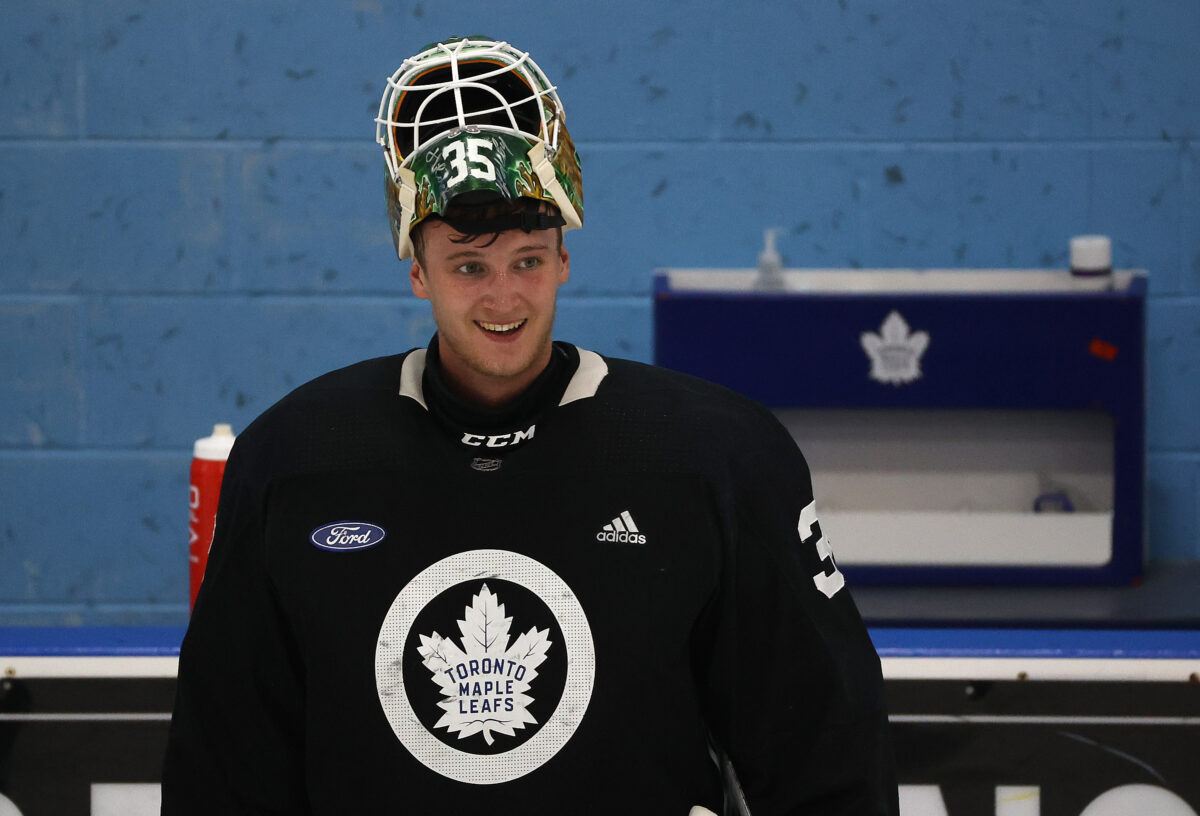
This season, Hildeby has split the Marlies’ net with Keith Petruzzelli and has been brilliant with a 2.37 GAA and .912 SV% along with four shutouts. His performance in the AHL got the Maple Leafs’ attention in January as they called him up after waiving Samsonov.
“A very proud moment,” said Hildeby on being called up. “It felt like I’ve done something good to get this call up … I feel like I’ve found my pace and been fairly consistent with my performances.”
Hildeby has the skillset to become an NHL goaltender in the future. Combined with his obvious size, he also is steady on his feet and reads the play very well. His quickness from side to side is also a strength as is his ability to find the puck through traffic and screens. If the Maple Leafs are lucky, they will have a solid 1A/1B tandem in the not-too-distant future, something they haven’t had in a long time – if ever.
9. Drew Commesso, 21, Chicago Blackhawks
Similar to the Minnesota Wild, the Chicago Blackhawks might need the services of their top goaltending prospect sooner rather than later. With a bare cupboard in the NHL that includes veteran Petr Mrazek as a bandaid solution, Drew Commesso could be in the starter’s crease as soon as Mrazek’s contract is over in 2026-27. Having said that, he might still need to battle with emerging goaltenders Jaxson Stauber and Arvid Soderblom, which would be good for his development since he wouldn’t be rushed into the starter’s role.
The now 21-year-old Norwell, MA native is another United States National Development Team product who chose the college route and has spent the last three seasons with Boston University. After a sophomore year that saw him improve on his numbers from his freshman campaign to post a 2.52 goals-against average (GAA) and .914 save percentage (SV%) and get named to the United States Olympic team, he regressed a bit in his junior year – but not by much, as he finished with a 2.46 GAA and .913 SV% in 34 games.
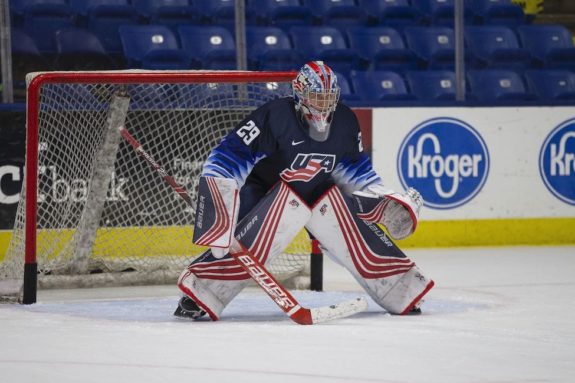
Selected in the second round of the 2020 Draft by the Blackhawks, Commesso has the stature (6-foot-2) every goaltender needs to succeed in the NHL these days. Known for his aggressiveness in the crease and ability to read the play, he definitely has the toolbox to take over the starting role in Chicago one day. Right now he is playing for the Rockford IceHogs in the American Hockey League (AHL) after signing his entry-level contract in April. As of this writing, he has a 2.81 GAA and .900 SV%, which is pretty good for an NCAA goaltender transitioning to the pros.
8. Arturs Silovs, 22, Vancouver Canucks
Arturs Silovs is on this list after a solid showing in the AHL, NHL, and IIHF World Championship last season. Selected all the way down in the sixth round by the Vancouver Canucks in 2019, the 6-foot-4 Latvian has slowly but surely inched his way to the top of the pool and is now the organization’s top goaltending prospect. Outperforming fellow netminder Mikey DiPietro, who was ultimately traded to the Boston Bruins, he took over the starting job in Abbotsford in 2022-23 and put up a respectable 2.44 GAA, .909 SV%, and four shutouts. He also had a winning record of 26-12-5 and was a big reason why they were in the playoffs at the end of the season.
Mixed in with his first full season in the AHL, Silovs also made his NHL debut with the Canucks and got into five games, including his first win on Feb. 18, 2023, where he made 35 saves in a 6-2 decision over the Philadelphia Flyers. He made his final start of the season on March 6 against the Nashville Predators and after his first shootout win, returned to the AHL for the playoffs.
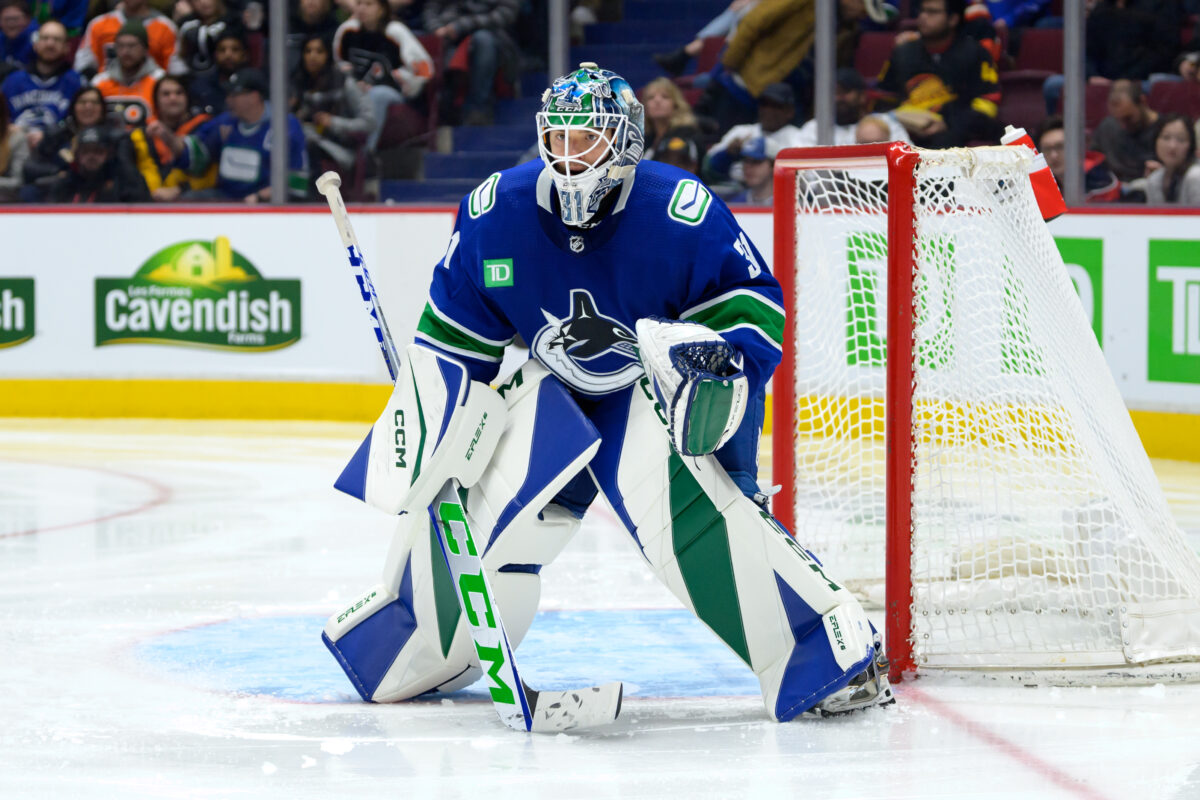
While Abbotsford was eliminated by the Calgary Wranglers, Silovs went on to star at the World Championship in Latvia and raised his stock to new heights as he not only led his country to their first medal ever – bronze – but also won the best goaltender award and MVP of the tournament. He ended up finishing with a remarkable 2.20 GAA and .921 SV%, including standout performances against powerhouses Team Sweden, Team Canada, and the eventual country he beat out for the bronze medal, Team USA.
Silovs has regressed a bit in his second season in the AHL, but still has a 2.85 GAA and .902 SV% in 31 appearances. He also has three shutouts – one off his total from all of last season. With Casey DeSmith being a free agent in the offseason, he could battle for the backup job in Vancouver next season, but will probably spend another year or two in the AHL considering his struggles in 2023-24.
7. Michael Hrabal, 19, Arizona Coyotes
Going into the 2023 NHL Draft, Michael Hrabal was one of the top names when it came to goaltenders. Ranked as high as 26th by Craig Button of TSN, and finishing second in NHL Central Scouting’s final rankings, he was projected to be one of the first goaltenders off the board. He ended up being selected after Adam Gajan (35th overall, Blackhawks), but the Arizona Coyotes were happy to see him still available when they were up at 38th.
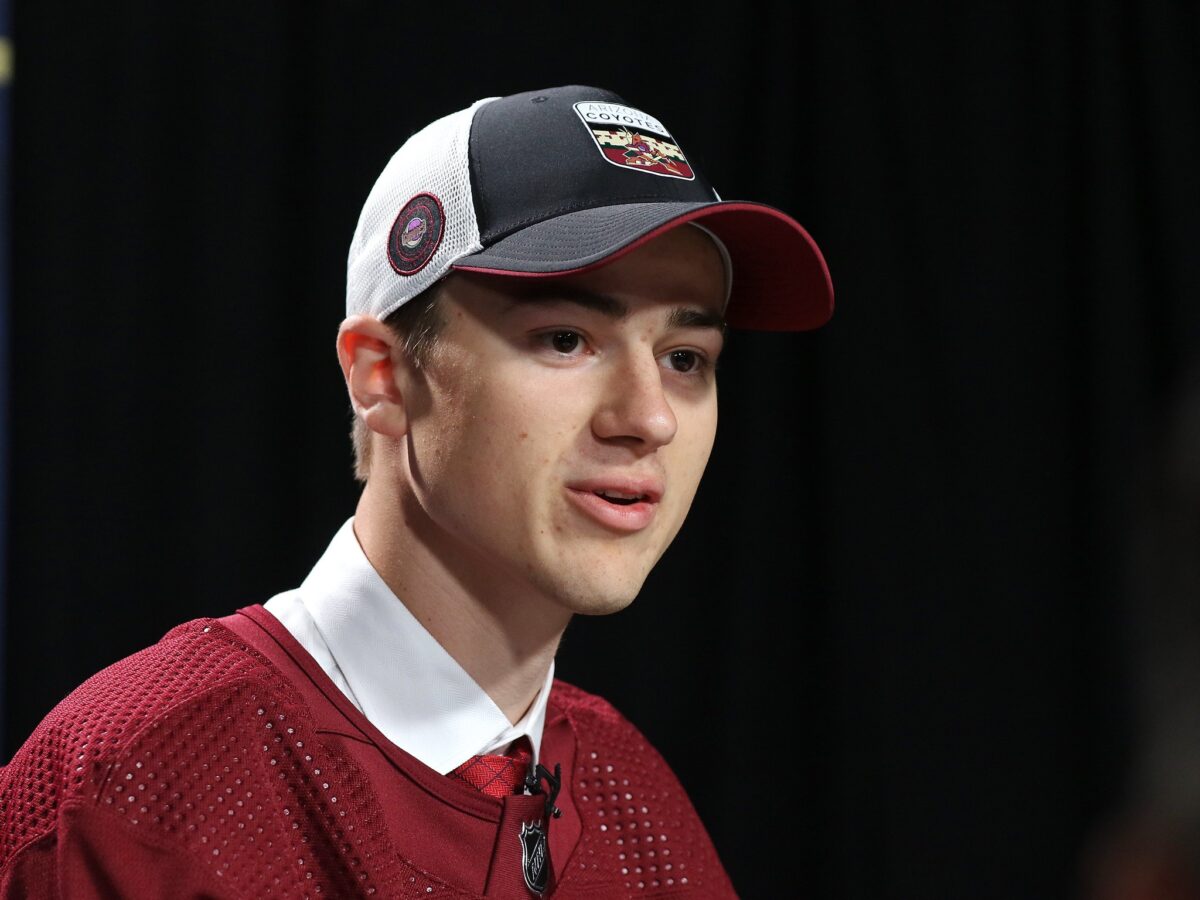
With a rare combination of size (6-foot-6) and athleticism, Hrabal could be number one on this list before long. After spending one season in the USHL with the Omaha Lancers, he joined UMass in the NCAA and is getting a surprisingly high workload for a freshman goaltender. And it’s easy to see why that is. He currently has a 2.46 GAA and .917 SV% with two shutouts in 24 appearances, which ranks in the top-five for freshmen.
Hrabal was also a prominent fixture on Team Czechia at the 2023 U18 World Championship and the 2024 World Juniors. He was a top-three player at both the U18s and World Juniors and helped lead his team to a bronze medal in 2024. The Coyotes’ goaltending pool needed a boost, and they got it with Hrabal, who could be taking over for either Connor Ingram or Karel Vejmelka in the very near future.
6. Trey Augustine, 19, Detroit Red Wings
Next up, the man that was selected a few picks after Hrabal, Trey Augustine. It was a little surprising to see who he went to though as the Detroit Red Wings already had Sebastian Cossa – ironically the next goaltender on this list – in their system. But with general manager Steve Yzerman holding two second-round picks in a row, it was kind of a no-brainer to select a first-round talent like Augustine, even with that being the case.
Augustine was ranked third on NHL Central Scouting’s final rankings, and was the third goaltender off the board after Gajan and Hrabal. Another standout for the USNTDP, he put up ridiculous numbers for the U18 and USNTDP Juniors teams in his draft year posting a 2.13 GAA and .926 SV% in the former and a 2.34 GAA and .928 SV% in the latter. He was also a star for Team USA at the 2023 U18s and World Juniors where he won a gold medal at the U18s and a bronze medal at the World Juniors.
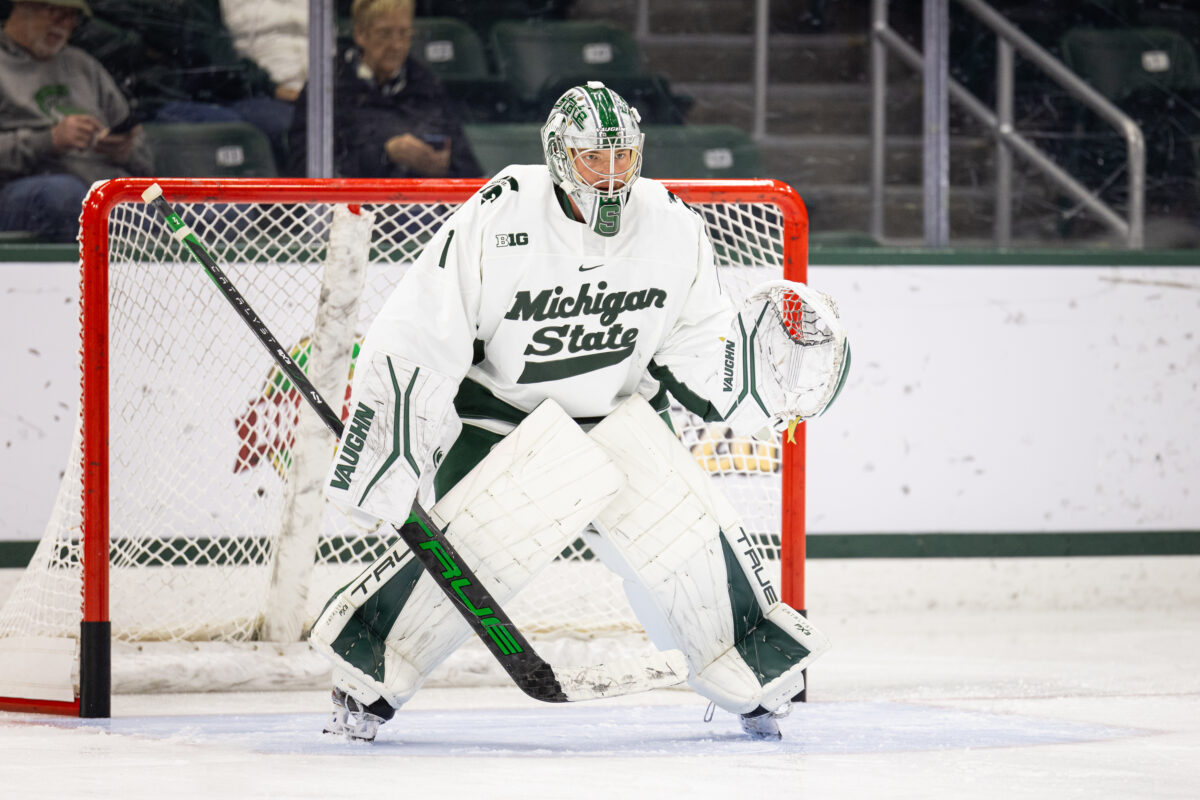
Transitioning to the NCAA in 2024 with Michigan State University, Augustine has taken the college world by storm, and just like Hrabal, is getting a ton of work in the crease. In 31 appearances, he has a 2.92 GAA and .917 SV% along with three shutouts and a ridiculous 20-8-2 record. He could have an NCAA championship before the season is over to go with the gold medal he earned as the starter for Team USA at the 2024 World Juniors.
Blessed with incredible athleticism and awareness in the crease, Augustine could end up being better than Cossa and form a lethal one-two punch in goal for the Red Wings in the future. Judging by his dominance at the NCAA level so far, he has the potential to be an elite starter in the NHL, something that would be welcome in Detroit as they have not had one since the days of Terry Sawchuk and Chris Osgood.
5. Sebastian Cossa, 21, Detroit Red Wings
Surprisingly drafted ahead of Jesper Wallstedt, Sebastian Cossa is still in the running to become a solid starter in the NHL one day. In what some would call an underwhelming season in his draft-plus-one year, he led the powerhouse Edmonton Oil Kings to a WHL Championship and a Memorial Cup Final appearance but did it with inconsistent play throughout the year. He also posted the worst GAA and SV% of his WHL career finishing with a 2.28 GAA and .913 SV% in 46 appearances and lost the starting job to Dylan Garand at the 2022 WJC.
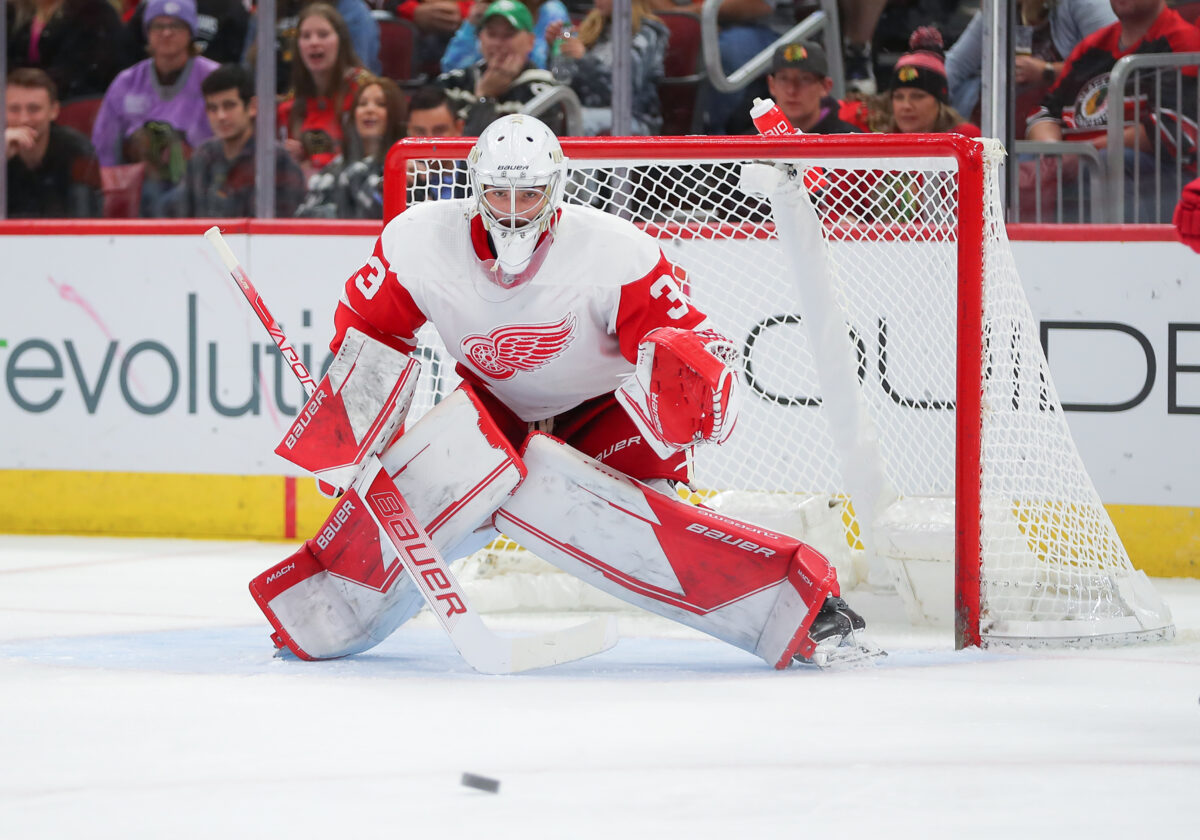
Spending most of the season in the ECHL with the Toledo Walleye, Cossa only got into three games with the Grand Rapids Griffins posting an ugly 5.57 GAA and .783 SV%. He was really good in the ECHL last season, but not at the level you would expect from a former top-15 draft pick – especially considering Wallstedt has already established himself in the AHL as a starter and could be on his way to NHL backup status as soon as 2024-25.
Fortunately for the Red Wings, Cossa has been pretty good in his first full season in the AHL. He is sporting a 2.57 GAA and .912 SV% and has a 13-7-5 record in 25 appearances. He is also garnering praise from veteran goaltender Michael Hutchinson.
“It’s been great,” Hutchinson said of the early stages of a partnership with Cossa. “He’s a great young kid. He’s a good person, first and foremost, which goes a long way. We were both excited for each other when we had big games early in the season.
“And then he’s got an insane amount of talent, and for him my role is just to be there for him if he has any questions or anything he needs to know. It’s fun working with someone who’s that young and that talented and just a good person.”
Despite Cossa’s initial struggles to acclimate himself to the pro game, he will eventually make his mark in the NHL as a starter with the Red Wings someday, as his toolbox of size (a gaudy 6-foot-6), athleticism, and ability to make saves in a variety of ways are things every goaltending coach, scout and general manager (GM) drool over. Basically what I am saying is, don’t give up on him yet. Furthermore, with Steve Yzerman’s success with his draft picks so far (see Moritz Seider and Lucas Raymond), it’s probably best not to doubt his choice of Cossa over Wallstedt.
4. Jesper Wallstedt, 21, Minnesota Wild
Wallstedt was selected 20th overall by the Minnesota Wild and looks to be the franchise’s future in net. At 6-foot-3 and 214 pounds, he has the size that NHL GMs crave between the pipes. He is large and very active in the blue paint. He doesn’t shy away from the spotlight as he tends to show up large in the game’s biggest moments. He has the smarts to go along with his elite technique, which has him considered a “can’t miss” prospect.
Wallstedt made the jump to the Swedish Hockey League (SHL) straight from juniors in 2020-21. He played very well in his 22 games for Lulea HF, going 12-10-0 with a .908 save percentage (SV%) and a 2.23 goals-against average (GAA) playing against Sweden’s top pros as a teenager. He also posted a .923 SV% and 2.40 GAA in his two appearances at the 2021 IIHF World Junior Championship.
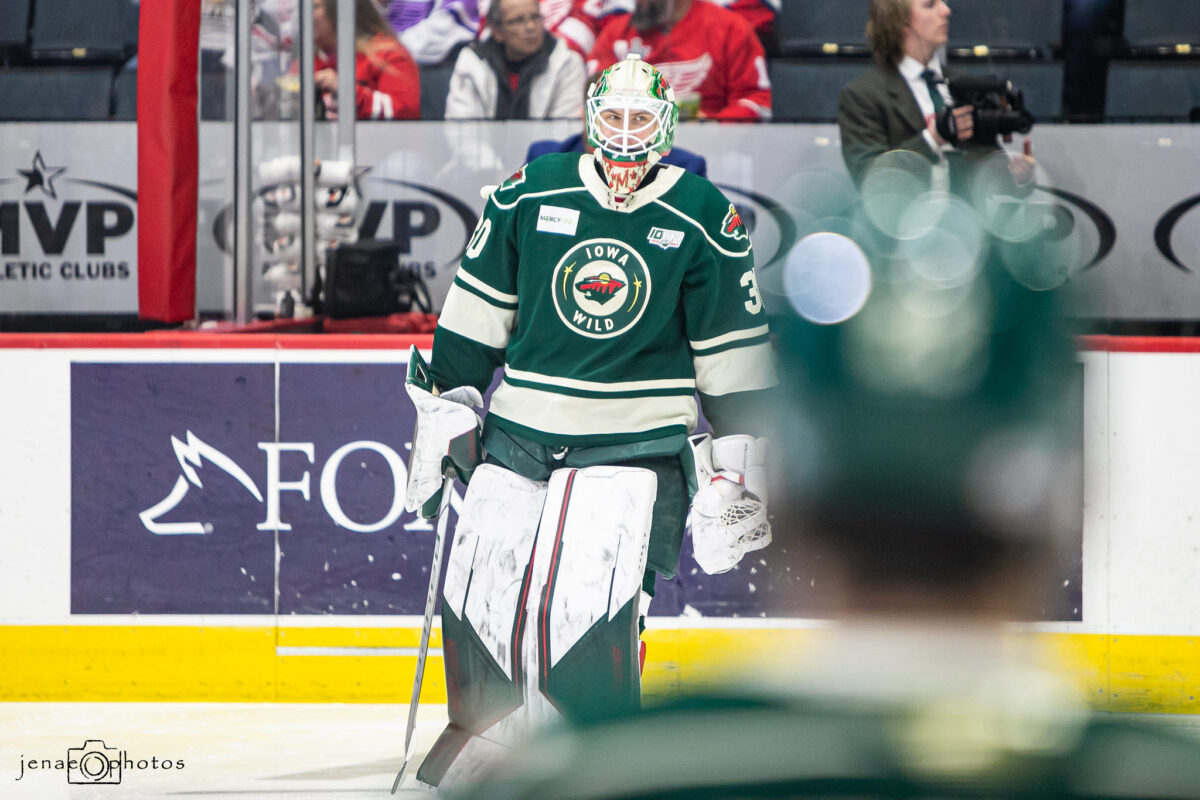
After being drafted by the Wild, Wallstedt returned to the SHL and continued to dominate as a 19-year-old. In fact, he ended up improving on the numbers from his draft year, finishing with a 1.98 GAA and .918 SV% along with three shutouts. Starring for Sweden at the 2022 rescheduled 2022 World Juniors in August, he outshined Cossa (who was selected five spots ahead of him) to the tune of a 1.62 GAA and .940 SV%; eventually leading his country to a bronze medal. He also was named the tournament’s top goaltender and a top three player on his team.
Wallstedt made his debut in North America last season and is currently playing in the AHL with the Iowa Wild. His numbers weren’t as otherworldly as they were in the SHL, but they were still solid. In 38 games, he posted a 2.68 GAA and .908 SV% and was named to the AHL All-Star Game. This season, he got his first start in the NHL, but had a rocky debut, allowing seven goals to the Dallas Stars in a 7-2 loss. He has struggled since then, allowing four or more goals six times in the last 13 games, proving that he still has more developing to do when it comes to his mental game.
With Filip Gustavsson starting to prove that he could be a starter in the NHL, Wallstedt likely won’t be in the NHL for a few more seasons. Considering the long development path of most goaltenders, that might not be a bad thing. He will be a star in the NHL one day, but only if the Wild take their time with him and develop him properly. Gustavsson’s emergence in the crease has only made that easier to do.
3. Devon Levi, 22, Buffalo Sabres
Devon Levi has emerged from the depths of the NHL Draft (212th overall in 2020) to become one of the biggest up-and-coming goaltenders in the sport. Now a Sabre after being included in the Sam Reinhart trade, his ascent started at the 2021 World Juniors when he broke Carey Price’s SV% record and finished with a minuscule 0.75 GAA and almost-perfect .964 SV% in seven games. Surprisingly walking away with only a silver after losing to the Americans in the gold-medal game, he still was deservedly named as the tournament’s best goaltender, a top-three player on Team Canada and was included on the All-Star ballot.
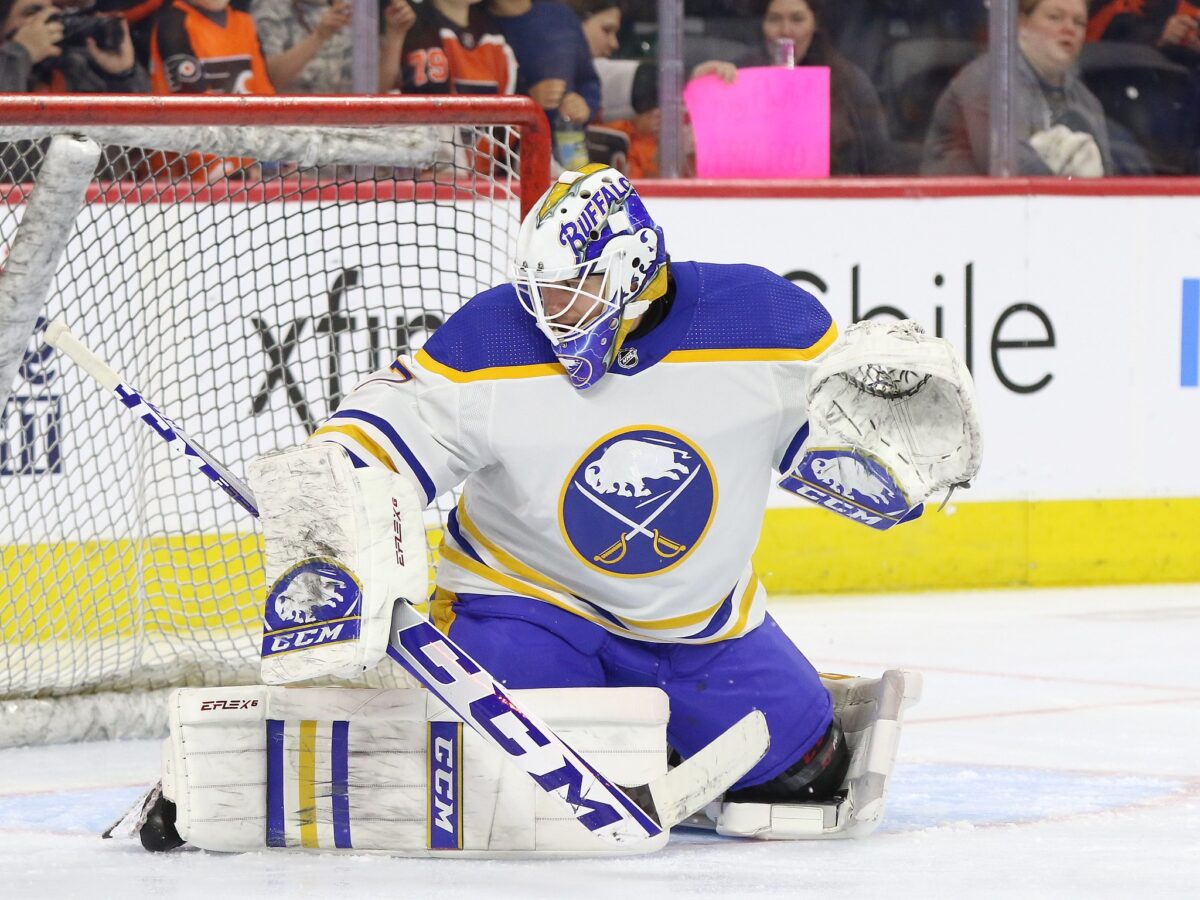
However, Levi didn’t let the disappointment of losing gold derail his development. No, he used it as fuel to dominate the NCAA with the Northeastern Huskies. Showered with accolades throughout the 2021-22 season, he was named an NCAA (Hockey East) Player of the Week six times, Rookie of the Week once, and Rookie of the Month three times. He also filled his trophy case with the Mike Richter Award given to the NCAA’s best goalie and the Tim Taylor Award given to the NCAA’s top rookie. Then to top it all off, he was named a finalist for the Hobey Baker. To say he had a good year would be a massive understatement.
Related: Sabres’ Goaltending Future Bright with Devon Levi
Returning to the NCAA for his sophomore season in 2022-23, Levi avoided the slump and posted a 2.24 GAA and .933 SV% in 34 games. He then signed his ELC with the Sabres and made his highly anticipated NHL debut against the New York Rangers and promptly recorded his first victory. Shutting the door with 31 saves, he led the Sabres to a 3-2 overtime win and quickly became a fan favorite. That was just the beginning too, as he finished with a 5-2 record. While his numbers weren’t out of this world (2.94 GAA, .905 SV%), he showed that he could play in the NHL.
Levi began the 2023-24 season in the NHL with the Sabres, but eventually was sent down to the Rochester Americans after a mediocre 3.30 GAA and .891 SV% in 20 appearances. It became clear that he needed more seasoning in the AHL, especially with how the Sabres’ defense was playing in front of him.
“Obviously it’s not easy information to take,” Levi said. “In retrospect, if you look at the big picture, it is a step down. But the conversation we had was not intentionally trying to take a step down, it was more using a resource to develop. With three goalies, I don’t think that we were getting the most out of everyone when we were up there. Being on my rookie contract, I don’t have to clear waivers and I’m able to play down here, so it just made sense” (from ‘Sabres prospect Devon Levi embracing ‘kick in the butt’ of getting sent to AHL,’ The Athletic, 11/29/23).
Levi has embraced AHL life and is doing quite well with a 2.49 GAA and .927 SV% in 14 games. He has been facing (and stopping) a lot of rubber in the Americans crease including a memorable night on Feb. 19 when he stopped 52 of 53 shots en route to a 2-1 overtime win over the Marlies. He has also faced at least 30 shots in nine of his last 10 games and has only allowed 24 goals for a gaudy .935 SV%.
Despite being slightly undersized at 6 feet, Levi uses speed and athleticism to make highlight-reel saves on a nightly basis and has proven to be difficult to beat in the AHL. If he can consistently translate those skills to the NHL, the Sabres’ crease might actually be a strength for the first time since Ryan Miller and Dominik Hasek were perennial All-Stars and Vezina Trophy candidates.
2. Dustin Wolf, 22, Calgary Flames
Dustin Wolf is undersized compared to the prototypical NHL goaltender these days at just 6 feet. That is a big reason why he fell to the Flames all the way in the seventh round (214th overall) of the 2019 NHL Entry Draft. What he lacks in height, he makes up with agility and athleticism in the blue paint. He has outstanding lateral movement and protects the bottom of the net well.
Wolf’s run in the WHL was quite impressive as he finished his career with 106 wins, a .935 SV%, 1.84 GAA, and 24 shutouts in 124 games. He led all WHL goaltenders in SV% and GAA during the 2018-19 season and again in 2019-20. He was also named the 2020 Canadian Hockey League (CHL) Goaltender of the Year after finishing the season with a spectacular .940 SV% and 1.88 GAA in 46 games.
The 2020-21 season was quite eventful for the now 22-year-old netminder. His first action of the season came for Team USA in the World Junior Championship. He made two appearances and did not allow a single goal as he and the Americans took home the gold medal.
From there, Wolf made his professional debut with the Stockton Heat in the AHL. He won two of his three starts with a .895 SV% and 3.24 GAA. He headed back to Washington for the start of the WHL season and excelled again with Silvertips, posting a .940 SV%, 1.80 GAA, and four shutouts in 22 games.
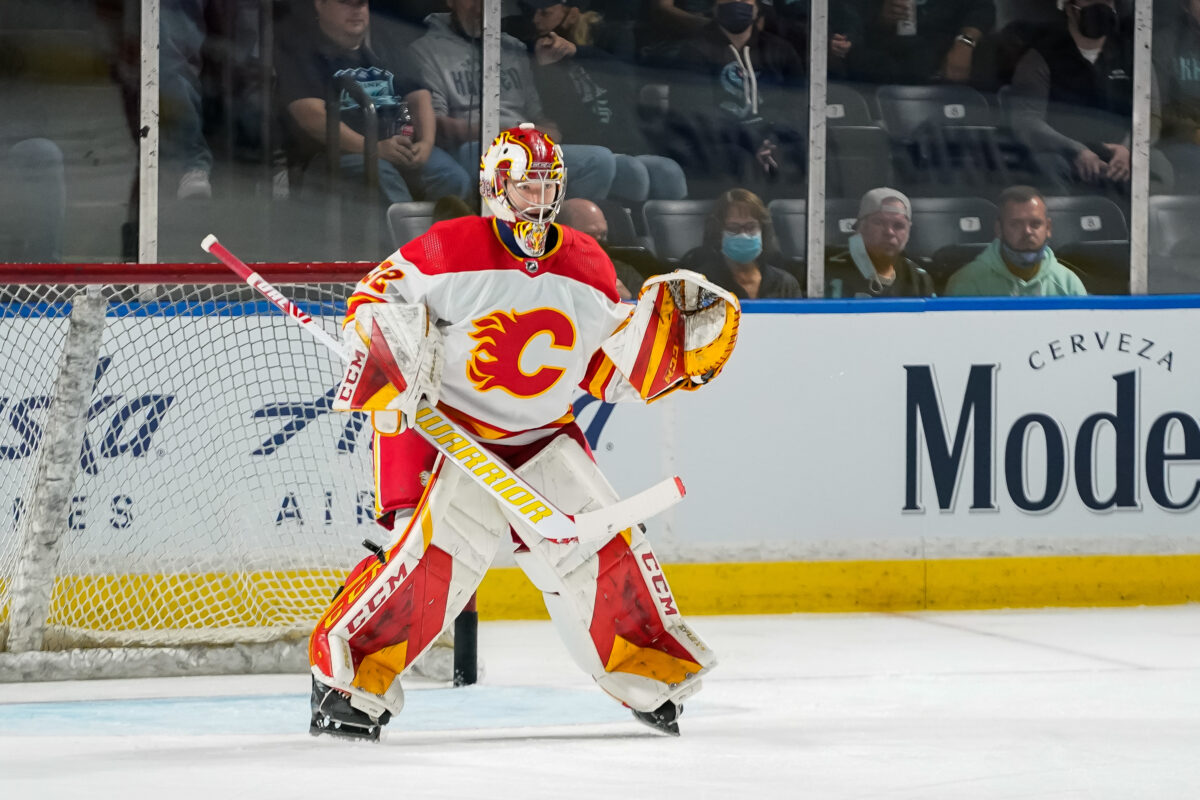
Wolf then transitioned to the AHL full-time in 2021-22 and continued to dominate, putting up a 2.35 GAA and .924 SV% along with a stellar record of 33-9-5. He also made hay in the Calder Cup Playoffs, finishing with a 2.23 GAA, .929 SV% and three shutouts as the Heat got eliminated in the Western Conference Final by the eventual champion Chicago Wolves.
Now in his third season in the AHL, Wolf is still one of the NHL’s top goaltending prospects. If his numbers from his first full season were impressive, then last season’s were out of this world. Finishing with a 2.09 GAA and .932 SV% – and seven shutouts – he led the newly-minted Calgary Wranglers to first in the entire AHL. He also led all goaltenders in wins, GAA, SV%, and games played. He even recorded his first NHL win in a late-season game against the San Jose Sharks and only allowed one goal on 24 shots. Suffice it to say, his ascent up the goaltending prospect ranks has been a steady burn (pun somewhat intended) and could force the Flames to move one of Jacob Markstrom or Dan Vladar sooner rather than later.
Wolf has gotten some time in the NHL this season, starting five games. Unfortunately, all but one of them have been underwhelming, leading to him falling to second on this list. He still has some developing to do, but it probably shouldn’t be in the AHL since he’s done all he can do there, considering he is dominating again this season with a 2.39 GAA, .924 SV% and four shutouts.
1. Yaroslav Askarov, 21, Nashville Predators
The foundation of the Nashville Predators’ success for the past decade was laid down in the crease. Pekka Rinne has built a Hall of Fame resume in Music City and has since passed the torch to Jusse Saros. With the future in mind, Nashville used the 11th overall pick of the 2020 NHL Entry Draft to select Jaroslav Askarov.
The teenage sensation was the highest-rated goaltender heading into the 2020 Draft. He was coming off a season that saw him dominate all three levels of Russian hockey, as he played nine games for SKA St. Petersburg in the KHL and put up a .920 SV% and 2.00 GAA as a 17-year-old.

Following the draft, he had another great season in Russia with another nine games in the KHL. He improved his numbers from 2019-20 with a .951 SV and 1.21 GAA and somehow went 5-4-0. Askarov’s performance at the World Junior Championship left a bit to be desired. Russia entered the tournament as one of the gold medal favorites, but he gave up five goals in a loss to the United States to open the tournament. He played well to get Russia into the elimination round but then allowed five goals to Canada in a semifinal loss and another four in the bronze medal game against Finland.
Askarov split his 2021-22 season between the KHL and VHL (Russia’s version of the AHL), where he posted a 1.81 GAA and .913 SV% with SKA St. Petersburg (KHL) and a 2.57 GAA and .899 SV% with SKA-Neva St. Petersburg (VHL). He also played three games in the VHL Playoffs where he recorded a 2.01 GAA and .937 SV%.
Askarov has all the tools to be a successful goaltender at the NHL level. His athleticism and powerful legs allow him to move from post to post at lightning-quick speed. His positioning in the crease is at an elite level, but he uses that quickness to recover on the rare occasion he is caught out of place. In what was a contract year for him in the KHL in 2021-22, he turned pro last season and made his debut with the Milwaukee Admirals in the AHL. In 48 games, he finished with a solid 2.69 GAA and .911 SV%.
This season, Askarov has elevated himself to the number-one goaltending prospect in the NHL. He has not only dominated the AHL with a 2.14 GAA, .920 SV%, and five shutouts, but he also made his debut with the Predators on Dec. 30 where he stopped 27 shots in a 3-2 shootout win over the Washington Capitals. He is probably only a year or two away from taking over from Juuse Saros – possibly even sooner if the trade rumors surrounding him are true. The Predators have been lucky with developing their goaltenders, as they appear to be going into the next decade with yet another solid starter in the crease.
All 10 of these netminders have the raw talent to become starting goaltenders in NHL. However, we all know that talent alone doesn’t always make it to the highest level of the game. As such, it will be fun to watch the journey of these youngsters and how many of them live up to their full potential.
All stats are current as of March 3, 2024
